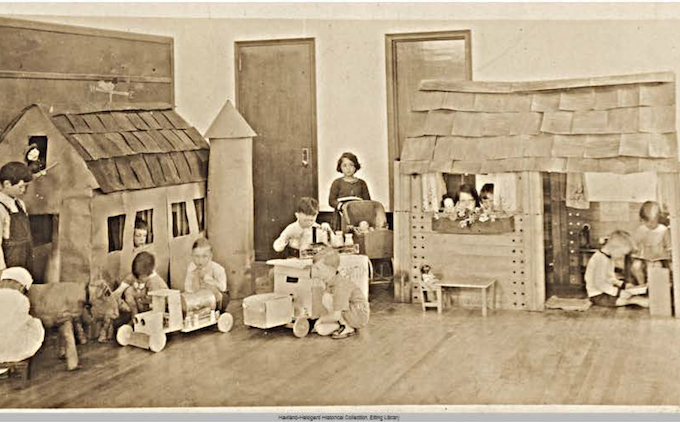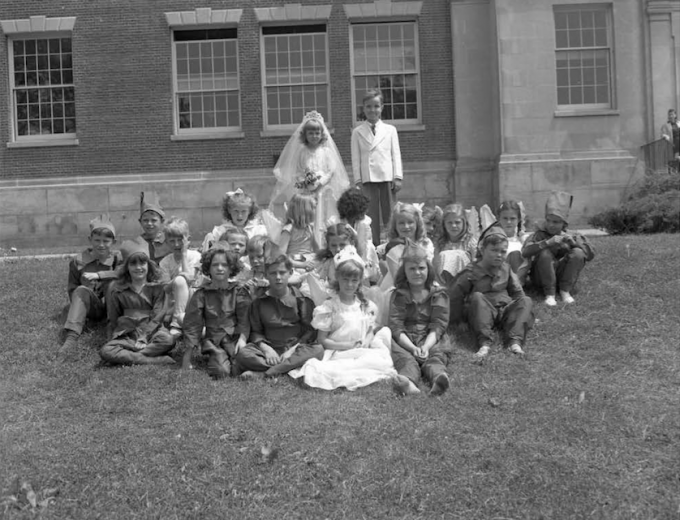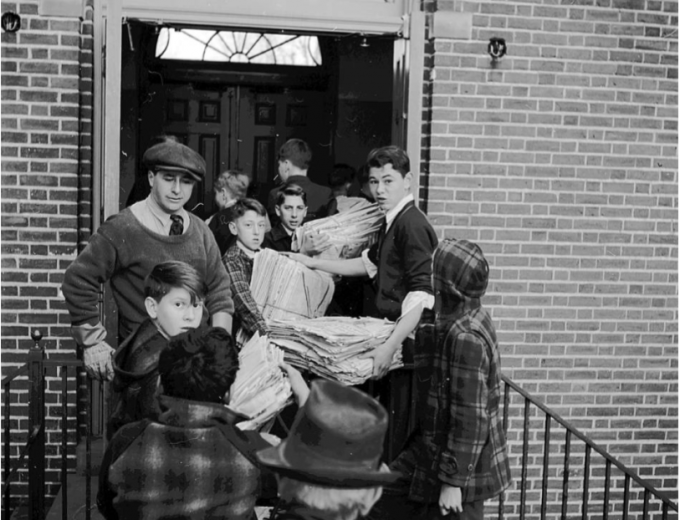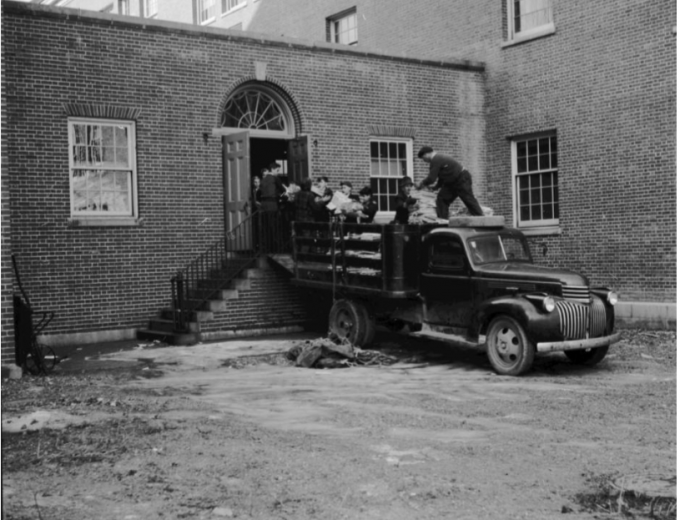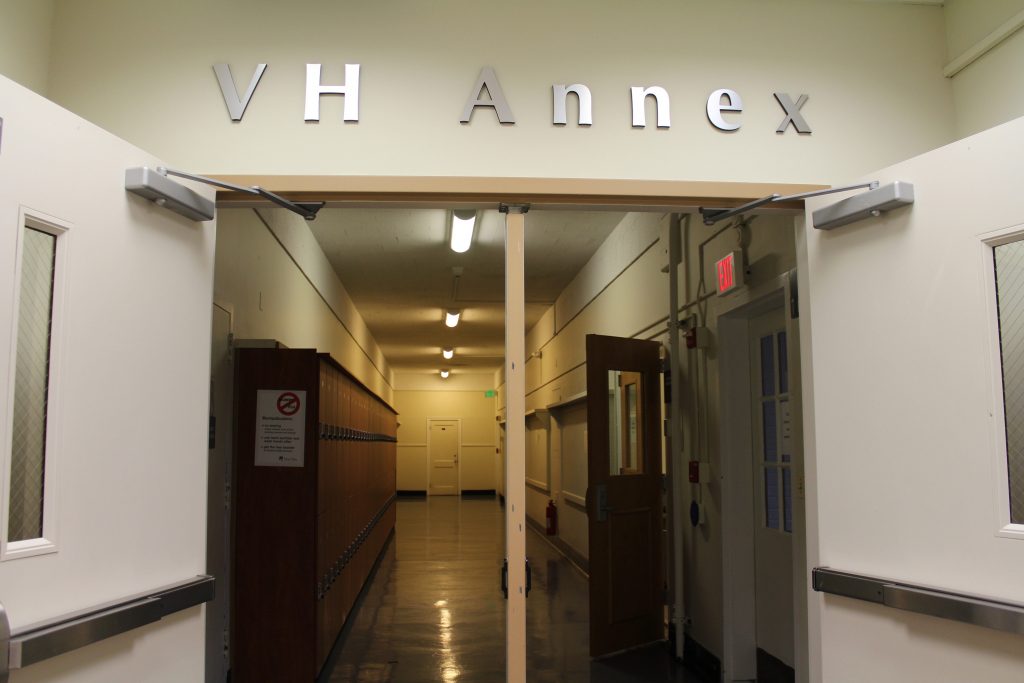
The Mystery
Admit it, we’ve all walked down the shadowy driveway between Old Main and van den Berg Hall and wondered what was inside the building next to it. Standing four stories tall with a rough brick exterior and some peeling white paint on the window panes, you begin to wonder what’s inside. Typical of a big building on a small campus like SUNY New Paltz, rumors run rampant and fuel all kinds of speculation.
- Is it an over-sized storage facility used by the College?
- Does it have extra dorm rooms for transfer students?
- Could it be a vacant citadel hiding treasure like Fort Knox?
Actually, the Annex serves an unexpected, but important purpose: it houses SUNY New Paltz’s Haggerty English as a Second Language (ESL) program, which operates under the Center for International Programs and caters to 41 students from 16 countries. According to Brenda Elliot, who worked in the Migrant Education Program (MEP) for 41 years until retiring in 2015, the Annex has long been associated with teaching foreign students in one way or another.
In addition to its current role as a hub of international cultural exchange, the Annex has a storied history that documents the evolution of the College from the turn of the century to modern times.
The Normal School
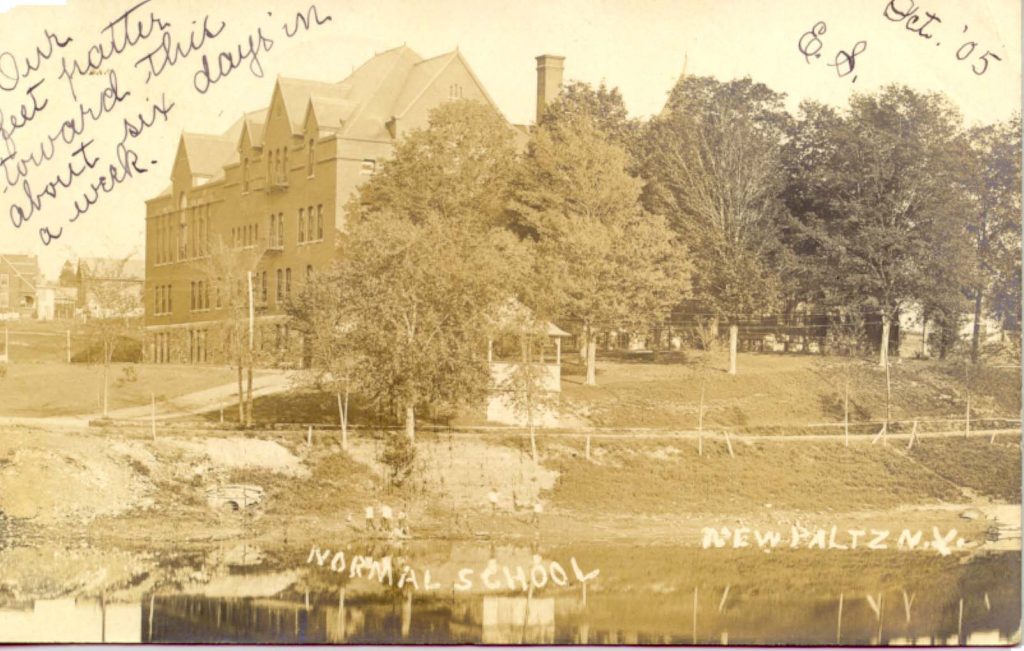
The origin story for the Annex began on May 25, 1885, when the New Paltz Academy offered its Normal School, previously located on Huguenot Street, to the New York State Department of Education. After a devastating fire in 1906, the building fell into disrepair as a litany of issues began to mount. In 1912, the state education commissioner openly discussed the idea of shutting down the high school within the Normal School since it was “not part of training for elementary teachers.”
In addition to the physical depreciation of the building, there were simply too many students with too few teachers. In 1924, there were 294 students and by 1927, there were 1,137. That same year, the state education commissioner Frank Pierrepont Graves announced his intention to discontinue the academic departments in normal schools statewide by September of 1929. Asked by a reporter for the Poughkeepsie Eagle News about the future of educational programs across the river, Graves said “it’s up to New Paltz.”
The local leaders did not take the threat lightly.
Judge G.D.B. Hasbrouck, a prominent figure in New Paltz, countered by saying that the sale of the Normal School to the State served as a contract to maintain the academic departments. However, former State Senator Ernest Cole countered Hasbrouck by calling that interpretation of the terms of the agreement “unconscionable.”
Given the dire odds, Benjamin Matteson, mayor of the village of New Paltz and the Normal School’s newly appointed director of training, had to assemble a plan to keep both the high school and his employer solvent. Luckily for Matteson, once referred to as the “Fiorella of the metropolis of southern Ulster County,” he had Bruyn Hasbrouck as well as Jay and Frank LeFevre in his corner.
The trio conducted a careful but deliberate public campaign to coalesce support from 10 outlying rural school districts in order to consolidate a high school based in New Paltz. On July 30, 1929, after months of dispelling rumors and misconceptions about the plan, consolidation was overwhelmingly approved by voters.
The high school was granted a stay in the same building as the Normal School until 1931, ultimately moving into a new building. From there, the board of education oversaw the high school while the Normal School oversaw the elementary school.
By the end of 1929, the new building was designed and approved by Dr. Lawrence Hoffman van den Berg, the principal of the Normal School since 1923. Nicknamed “The Chief,” van den Berg led the institution for 20 years before assuming the first presidency of the New Paltz State Teachers College in 1943.
On October 25, 1930, Governor Franklin D. Roosevelt broke ground on the $385,000 building for the Normal School. Upon opening in 1932, the school catered to four year olds in nursery through the eighth grade. Two years later, the building was dedicated as the “Lawrence H. van den Berg School of Practice.”
The Campus School
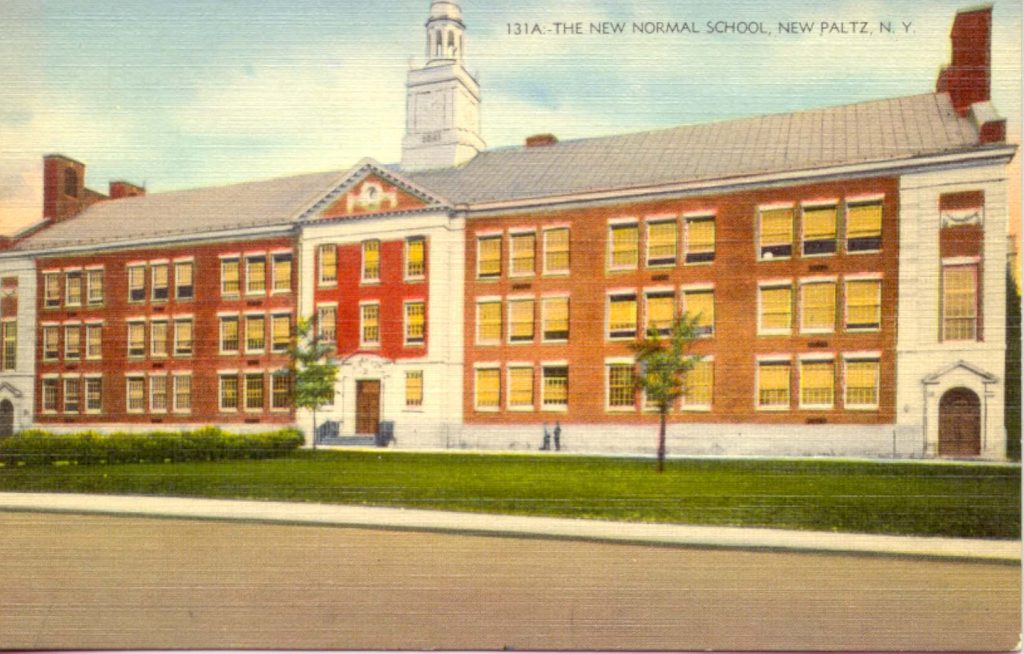
The Annex, meanwhile, was simply known as the “Middle Building.” It was approved at a cost of $182,000 in 1932 and was finally erected two years later for an additional $10,000. It originally served as a heating plant with a cafeteria, auditorium and a gymnasium on the fourth floor. A small TV control room was added later.
The first ninth graders were accepted on Sept. 10, 1934. The early years fostered a vibrant community for educators, student teachers and the youth of the New Paltz area. December of 1936 saw a “musical renaissance” in the middle school, featuring holiday carols in the hallways and a Christmas play. During the 1943-44 school year, in the midst of World War II, the sixth grade class raised over $4,000 in war stamp sales.
From 1946 to 1953, the Campus School housed all public elementary classes in the village, admitting students through a lottery system as well as operating a three and four-year-old nursery. In an average year, there were a total of 450 students, two classes per grade and a staff of 35.
The first edition of the “Junior Oracle,” a middle-school version of the College’s student-run newspaper, The New Paltz Oracle, was published on March 21, 1957. The editor-in-chief at the time was an education major who assisted her students in writing and compiling the publication.
During the 1956-57 school year, the Campus School began accepting ninth grade admissions once again. At the same time, the New Paltz Central School opened, offering K-12 admissions. The experiment was short-lived for the Campus School, as they dropped the ninth grade for the 1968-69 school year, calling the decision “ideal” for the institution.
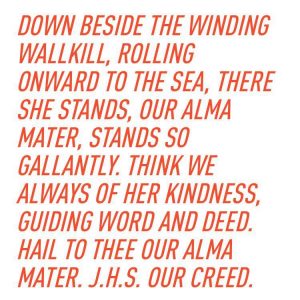
What followed was the beginning of the end for the Campus School. In 1976, the school faced its first public call for closure as there were essentially two K-8 schools operating in the same small community. Successfully staving off closure during the mid-1970s was moot upon the arrival of Dr. Alice Chandler in 1980. For 16 years, Chandler served as president of SUNY New Paltz and made her presence known early on by closing the Campus School.
According to former New Paltz town councilwoman Kristin “Kitty” Brown, there was some public outrage when Chandler chose to close to the Campus School. Brown said that Chandler was offered an exchange where the land would be given to the SUNY system and in return, New York State would provide tax-free elementary school education for the community. With the deal finalized, the Campus School closed the middle school in 1981 and held its final graduation ceremony on June 3, 1982.
Brown, whose daughter Lydia attended the Campus School until its closure, commented that it was a wonderful school as well as “a great loss for our family and our community.” She added that the school always marked the end of the academic year with a celebration that included a huge circle dance with all of the parents, staff and children.
“The instructors taught Montessori, Piaget and other educational philosophies that I can’t remember,” Brown said. “I remember the open classroom, which I believe was pre-K through first grade, and a wonderful way for young children to observe the activities that older children were participating in. One very important activity was cleaning up after the day. I remember my daughter coming home from school in tears one day because she thought that she didn’t know how to sweep well enough and she wanted to practice at home.”
After its closure, the building still found some use, operating as a nursing school for a period of time during the 1980s. By January of 1990, the building reopened as part of the College. Despite the resurrection of the old building, it was not all roses. During the early morning hours of May 19, 1990, a mere four months after reopening, a fire engulfed the original clock tower on top of van den Berg Hall. An $11 million renovation began in April of 1991 and in January of 2005, a $500,000 replacement clock tower was lifted into place.
The Memories
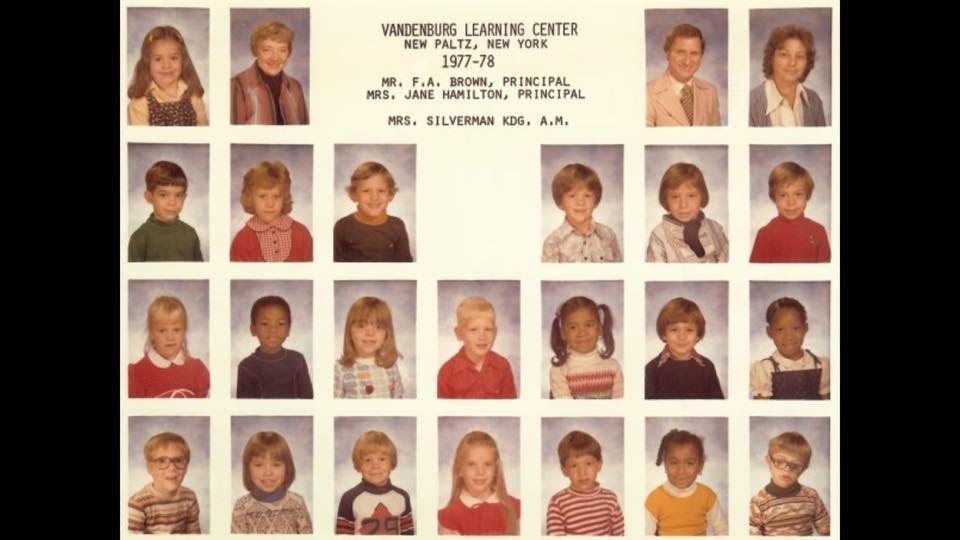
On Labor Day of 1950, Mary “Mac” Jewett finished her long drive from the Midwest by arriving in New Paltz, where she would teach at the Campus School for the next 31 years. Soon after retiring, Jewett wrote an essay describing the simple daily life of being a teacher in New Paltz.
She mentioned how Frank VanGonsic used to drive the bus to bring country children to school and that Principal Harold Ellsbee expected teachers to be ready to show up to work, even on snow days. She shared memories of how the playground in Hasbrouck Park was flooded during the wintertime in order to be used an outdoor public skating rink. Jewett described the Campus School as “small but good start,” where values were learned while fostering a “family atmosphere and life-time friendships.”
In composing this story, many locals shared memories of time spent at the Campus School as well as the Annex. A frequently mentioned memory focused on the unusual fourth floor gymnasium which hosted many Catholic Youth Organization (CYO) basketball games between St. Joseph’s and other local parishes during the 1960s. Tim Rogers, mayor of the village of New Paltz, remembered playing plenty of CYO basketball there as a child in the 1970s.
“I also did some preschool at the Campus School,” Rogers said. “One day, I was heading to preschool carrying a large Tonka truck. I tripped on the stairs to the building and fell face first into the Tonka truck and needed stitches for my forehead. I regularly walk by those stairs and think about my three-year-old self wiping out that day. I was in middle school when the Campus School closed. It was very exciting getting the influx of new classmates. To this day, some of my best friends were originally ‘Campus School kids,’ – artsy more hippy kids.”
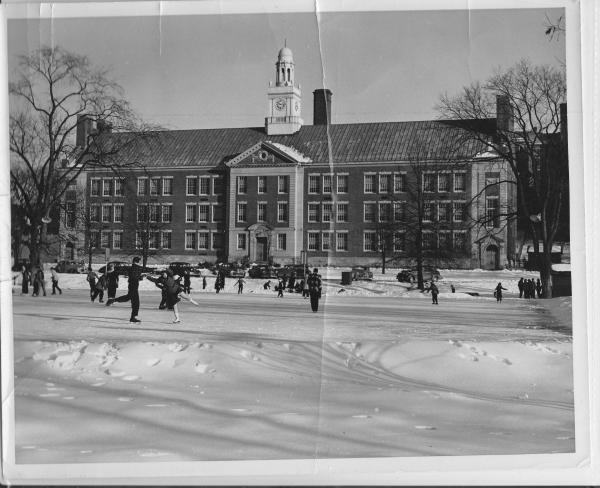
Another indelible part of van den Berg’s lore is the infamous ladder that served as an escape mechanism for adventurous students seeking to summit the building. KT Tobin, Village Trustee-elect and associate director of the Benjamin Center, stated the secret ladder was hidden behind a locker that kids climbed up to get to the clock tower. Others debated the intrigue surrounding the ladder, saying that it was not a secret but rather a continuation of access the ladder to the attic.
Local resident Maya Projansky related the oft-repeated story of a student who was fed up with school, so he liberated himself by going out of the third story library window and climbing down the ivy that covered the front of the building.
“My office used to be in the [Annex] which also had a fully operational kitchen from the 1950s,” said Kathleen Geher, Director of the Dual Diploma program. “I do know the third floor housed the locker rooms with sneaky steps up to the fourth floor gym.”
Local resident Fred Rogers responded to my thread on Facebook with his own memories of the facility.
“I spent time in that building during the mid-1990s because my best friend’s mother worked upstairs in the MEP and we would snoop around while waiting for her to drive us home after work,” Rogers said. “I never knew the Annex housed the Campus School, (which two of my older brothers attended), until reading this thread today. I do remember thinking that the building seemed odd because at that time it was very dark and empty, especially the large cafeteria downstairs. We loved poking around in the little room on the first floor with the manual die cut machine and the walls stacked full of different dies. I wonder if they are still there – and if not what became of them! That was an awesome machine.”
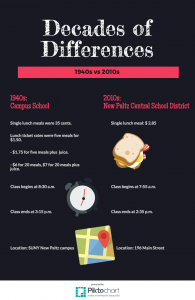
The ESL Program
During its heyday, the Campus School hosted International Night, a popular annual event supported by State University College, New Paltz President Dr. William Haggerty. During his 22 years at the helm, Haggerty consistentl sought to include international guests, cultures and influences on campus. Soon after he left the College in 1966, Haggerty became the president of the Conference of World Affairs, Inc., following one of his great passions until 1975.
Intentionally or not, the function of the Annex has been in line with the New Paltz’s long history of honoring international culture, either through hosting International Night or housing the MEP.
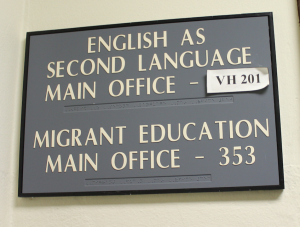
Connie Perdreau has been the director of the Haggerty ESL Program since 2008. Perdreau graduated from SUNY Potsdam and earned her masters from Ohio State University. While in college, Perdreau studied abroad in France and graduated with the goal of becoming a French teacher. After a year of teaching in Yonkers, she decided to attend Ohio State University for her master’s degree. It was there that she heard about ESL, which combined her interests in linguistics, cultural exchange and ultimately changed her life.
“It’s a joy to deal with a student or young person and try to help guide them,” Perdreau said. “It’s a positive impact getting international students to interact with Americans and know each other as friends. It happens in ways you can’t describe. If people in power knew people as other than nationalities, the world would be a better place.”
Perdreau said that she hopes to eventually grow the program to encompass students from over 40 countries. Additionally, she aims to further integrate the students into the campus community whether through clubs, athletics or housing. She acknowledged that her students have spent a considerable amount of money for the opportunity to attend SUNY New Paltz and she wants to maximize their experience for them.
“When they come here, they get a degree but they’re also an ally, they’re a friend of America,” she said.
An appreciation for foreign cultures and travel runs deep within the leaders of the Haggerty ESL program. Jason Serrano graduated in 2015 with a degree in Asian Studies and now serves as a student adviser for the program. He has worked in that capacity since returning from Japan in the spring of 2016. Carmen Deng is a graduate student originally from China who has been at SUNY New Paltz since 2011, and is currently finishing her MBA.
Deng was originally in the program for a year and a half, and discussed how students are placed and can grow in the program. When a student is accepted, they are given the TOEFL test, which measures a person’s ability to understand and speak English. The test is based on reading, writing and listening, with students being placed on a scale from A, B, C and then AP. Deng began in A when she first arrived from China, but soon advanced to C.
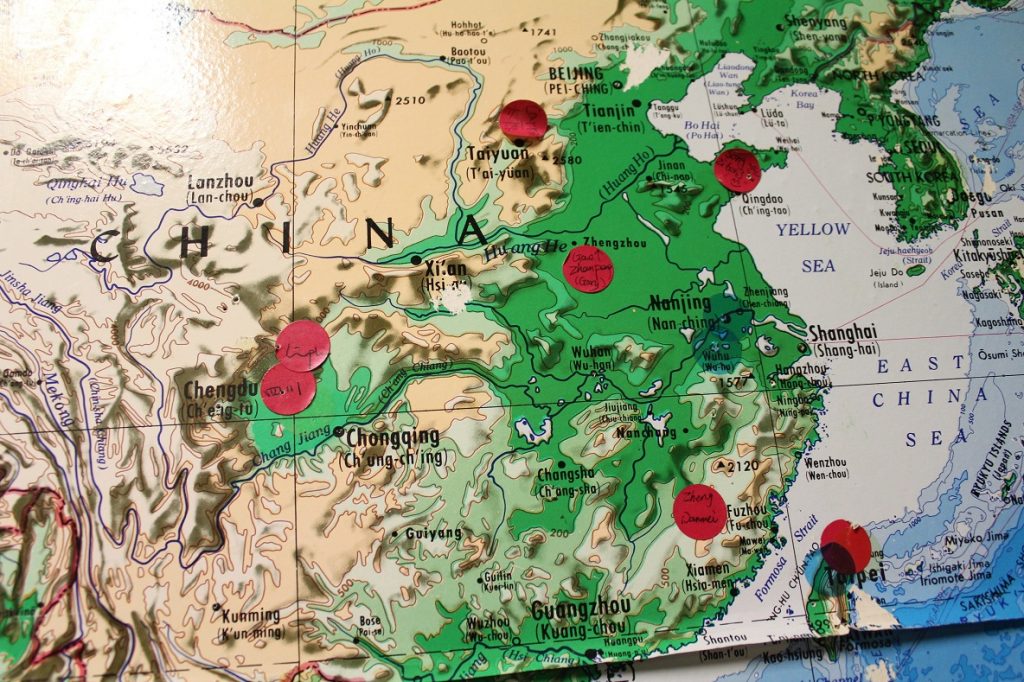
Like Deng, most students come from Asia, typically from Japan, China and India. However, not all students are youths from foreign countries. The program has offered admission to domestic transfers who live in the U.S. and might be in pursuit of a degree or simply to improve their proficiency. According to Perdreau, last year the program hosted seven nuns from the Cabrini Religious Foundation, who studied in the program in order to improve their English skills before travelling. Additionally, a carpenter from Japan as well as a professor’s wife originally from Ethiopia studied in the program.
Students are assigned three core classes and one special topic. In addition to TOEFL, a Briggs-Myers test is administered to students as under-graduate preparation. From there, the timeline for students in the program varies by degree and what their expectations are. Some students stay in the program for years, but most go home during the summer. According to Serrano, some students apply for conditional undergraduate degree or utilize the Pathways Program as a stepping stone to a degree.
Outside of the academic side of the program, Perdreau makes sure her students have plenty to do, including interacting with their American counterparts. The fourth-floor gymnasium, long removed from hosting basketball games, now hosts conversation tables, game club and holiday celebrations. These include parties for Halloween, Thanksgiving, Valentine’s Day and White Day, which is an Asian romance holiday celebrated on March 14.
Sports are played in the gymnasium, too, with one of the most popular games being speed-minton, which is a quicker version of badminton. The program relies on grants from Campus Auxilary Services (CAS) in order to purchase equipment, like the ping pong table. Much like in the movie “Forrest Gump,” ping pong serves as an effective instrument of cultural exchange, as well as their karaoke machine.
The program has its own own publication: “The ESL Times,” which is written by students in the program. They also take part on planned field trips throughout the semester, including to the U.S. Military Academy at West Point, Albany and Washington, D.C.
The Students and the Speaker
Both Serrano and Deng were helpful in providing us with an audience of students to speak to after they got out of class. The first one was Arbm, a 17-year-old from Albania, who has been in the program for almost a year. Kind and soft-spoken, he said that New Paltz has been a new experience for him, highlighted by the program’s trip to Mohonk Mountain House.
After him was Ben, from South Korea, who has been in the program for three months and lives in Shango Hall. A common misconception is that students live in the Annex, but Serrano reiterated that students live on campus. He has previously travelled to New York City and Las Vegas, but is only staying for one semester and then going back home. Another previous traveller was Mohammad, a 25-year-old from Saudi Arabia, who has been here for two months after previously studying in San Diego, California.
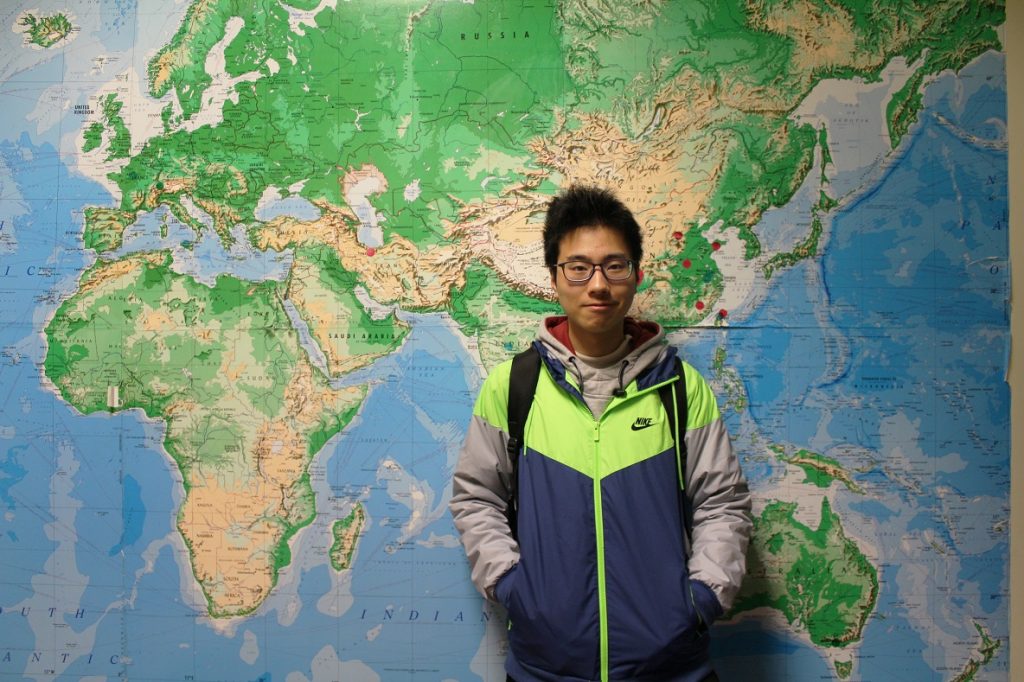
Towards the end of our interviews with students, we were introduced to Chang Shu, an 18-year-old from China who holds the unofficial title as the “Speaker of the ESL Program.” As I grabbed my notebook, a friend of Shu’s walked past us and said “He can talk for hours.”
He was not wrong. Shu took up a whole page of my notebook, speaking quickly and enthusiastically about his brief time so far in New Paltz. The average age for students in the program is 20 years old, putting Shu on the younger side. However, that makes him far from timid. In fact, Shu is as gregarious as they come, considering himself a glass-half-full kind of guy.
“I’m special, I like to raise questions and communicate,” he said. “I’m a positive guy, I don’t think in bad ways.”
Shu took English classes in high school but says education in America is “totally different” than it is in China. He highlighted the various uses of tenses when speaking in America, as well as the encouragement to engage with subjects and ask questions during class. Shu appreciates the discussion-based classes, noting how speaking in English is important.
Shu is considering finishing his undergraduate degree here. He hasn’t settled on a major but says many things are possible, including international relations, psychology, computer programming and electrical engineering.
